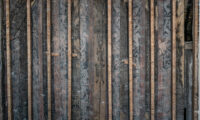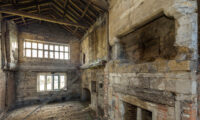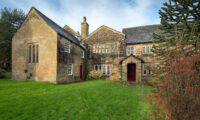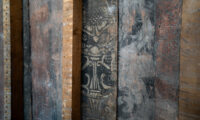 A complete 16th century wall painting has been discovered beneath a 19th century plaster wall at Calverley Old Hall in Leeds, Yorkshire. The painting covers the full surface of the Tudor wall. It was done in black, ochre and white pigments in the grotesque style, featuring fantastical beasts and men with climbing vine ornaments and columns. The date of the work could be as early as the 1540s. Most surviving wall paintings in English homes date to after 1575, so this could prove to be an exceptionally early example.
A complete 16th century wall painting has been discovered beneath a 19th century plaster wall at Calverley Old Hall in Leeds, Yorkshire. The painting covers the full surface of the Tudor wall. It was done in black, ochre and white pigments in the grotesque style, featuring fantastical beasts and men with climbing vine ornaments and columns. The date of the work could be as early as the 1540s. Most surviving wall paintings in English homes date to after 1575, so this could prove to be an exceptionally early example.
![]()
 Grotesque was all the rage at the time, spurred by the rediscovery of the Domus Aurea in the 1480s and the Renaissance masters like Raphael and Michelangelo who were inspired by its wall frescoes. From Italy the style spread to Northern Europe where engravers printed illustrated books that were widely used as references by artisans. The grotesque wall paintings at Calverley Old Hall were likely made by local or traveling artists working off print books like these.
Grotesque was all the rage at the time, spurred by the rediscovery of the Domus Aurea in the 1480s and the Renaissance masters like Raphael and Michelangelo who were inspired by its wall frescoes. From Italy the style spread to Northern Europe where engravers printed illustrated books that were widely used as references by artisans. The grotesque wall paintings at Calverley Old Hall were likely made by local or traveling artists working off print books like these.
 The Grade I-listed manor house has surviving elements that go back to 1300 and was extensively remodeled, added to and subtracted from for centuries. The last major addition dates to the first half of the 17th century. The Calverley family sold the estate in 1754 and it was divided into cottages. Except for the divider walls that separated the space for cottage tenants, the manor house is largely unaltered. The Landmark Trust bought Calverley in 1981, restoring two cottages for let. Since then it has restored the Chapel and the roof of the Great Hall, but the rest of the property, including the early 15th century timber-frame Solar Wing, unique in the country, and the interior of the late 15th century Great Hall, has simply been kept weathertight to protect it.
The Grade I-listed manor house has surviving elements that go back to 1300 and was extensively remodeled, added to and subtracted from for centuries. The last major addition dates to the first half of the 17th century. The Calverley family sold the estate in 1754 and it was divided into cottages. Except for the divider walls that separated the space for cottage tenants, the manor house is largely unaltered. The Landmark Trust bought Calverley in 1981, restoring two cottages for let. Since then it has restored the Chapel and the roof of the Great Hall, but the rest of the property, including the early 15th century timber-frame Solar Wing, unique in the country, and the interior of the late 15th century Great Hall, has simply been kept weathertight to protect it.
 After a major fundraising appeal, the Landmark Trust has undertaken a comprehensive restoration of Calverley. The first phase is a thorough documentation of its current derelict state. The restorers were removing small areas of 19th century plaster in a cottage behind the Solar Wing to inspect the timber framing for any rot or damage when they spotted streaks of color on the oak. They called in specialists to investigate further. Removal of plaster from five more spots on the wall revealed the colors were part of a wall painting. Full removal off the plaster and lath exposed a complete wall-to-wall, floor-to-ceiling mural.
After a major fundraising appeal, the Landmark Trust has undertaken a comprehensive restoration of Calverley. The first phase is a thorough documentation of its current derelict state. The restorers were removing small areas of 19th century plaster in a cottage behind the Solar Wing to inspect the timber framing for any rot or damage when they spotted streaks of color on the oak. They called in specialists to investigate further. Removal of plaster from five more spots on the wall revealed the colors were part of a wall painting. Full removal off the plaster and lath exposed a complete wall-to-wall, floor-to-ceiling mural.
 The top frieze of the mural features alternating Tudor roses and pomegranates. Symbol of the resurrection of Christ, a pomegranate (granada in Spanish) was added to the royal arms of Ferdinand and Isabella after the conquest of Granada in 1492 and their daughter Catherine of Aragon joined her family’s pomegranate to Henry VIII’s rose for her heraldic badge after her marriage in 1509. The two appeared frequently in prints, reliefs and manuscripts until the queen’s arms were replaced by the new queen’s arms when Henry married Anne Boleyn in 1533. The painting was done after both Catherine of Aragon and Anne Boleyn died and is likely a reference to the Calverleys’ Catholicism.
The top frieze of the mural features alternating Tudor roses and pomegranates. Symbol of the resurrection of Christ, a pomegranate (granada in Spanish) was added to the royal arms of Ferdinand and Isabella after the conquest of Granada in 1492 and their daughter Catherine of Aragon joined her family’s pomegranate to Henry VIII’s rose for her heraldic badge after her marriage in 1509. The two appeared frequently in prints, reliefs and manuscripts until the queen’s arms were replaced by the new queen’s arms when Henry married Anne Boleyn in 1533. The painting was done after both Catherine of Aragon and Anne Boleyn died and is likely a reference to the Calverleys’ Catholicism.
So who might have commissioned these wonderful paintings? The dendrochronology suggests that the roof (and therefore main structure) of the block was built 1514-39. The block had two phases (perhaps beginning as a stair turret) and its floor was inserted later, between 1547-85. This is a tantalisingly wide span of dates that covers a multitude of national and family events. The archaeology currently suggests the later period for the paintings – but even that is excitingly early.
At the moment, the most likely person to have commissioned the painted chamber seems to be Sir William Calverley (c. 1500-1572). He was knighted in 1548, and became Sheriff of York in 1549, a man of high estate and important affairs. We believe that the painted chamber was only ever reached at first floor level from the family’s private rooms and had its own private access directly onto the gallery of the family chapel. Perhaps it was Sir William’s privy chamber, where he entertained only his closest friends and associates. Or perhaps it was his second wife, Elizabeth Sneyd’s private parlour, a refuge from vigorous Sir William’s seventeen offspring.
The Landmark Trust is now raising funds to thoroughly conserve and display this unique artistic treasure. Donate online here.